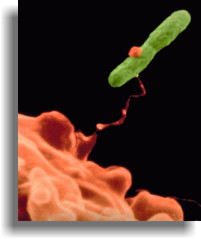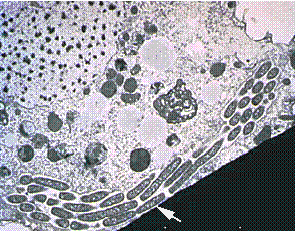Legionaire's Disease
An amoeba (red) pulling a Legionella bacterium (green) into the amoeba cell.

LD is extremely difficult to eliminate because the bacteria can infect paramecium and amoeba as a parasite. These one-celled organisms are extremely difficult to kill as they can tolerate relatively high levels of halogens.
The bacteria are shed into the water by the cell periodically and then can be aerosolized into the air where they can infect people.
Cross Section of Legionella chains

Transmission electron micrograph showing cross section of Legionella chains
In order to protect all who work near cooling towers, ACT recommends that all cooling towers be cleaned periodically by using the procedure outlined by the Centers for Disease Control and Prevention (CDC) in Atlanta, GA. For your benefit, that procedure is re-printed below.
ACT personnel are experienced in these procedures and if requested, can do them for you. We also stock the necessary chemicals and equipment for you to have your own in-plant personnel do the work. Regardless of who does it, the CDC recommends that this be done as a minimum twice per year. Once when you start the cooling tower up and again at the end of the season when you shut it down. For those facilities that run year round, we recommend that the procedure be done on a quarterly basis.
ACT has portable pH and ORP monitoring and control systems that can be used to automatically maintain the correct pH and halogen levels in your system. Additionally, the controller that we use will log both the pH and ORP levels every five minutes. This information can then be downloaded to a laptop computer and graphed with any spreadsheet or database program. The controller will also inform you of how often and for what duration the feed equipment was on. This can be an important record for any plant. If you have any questions concerning this procedure or our portable equipment, please email them to act@actglobal.net
CDC Procedure for Cleaning Towers infected with Legionella
PROCEDURE FOR CLEANING COOLING TOWERS AND RELATED EQUIPMENT
(Adapted from the Emergency Protocol in Control of Legionella spp. in Cooling Towers: Summary Guidelines.[464])
I. Preparatory to Chemical Disinfection and Mechanical Cleaning
A. Provide protective equipment to workers who would perform the disinfection, to prevent their exposure to (a) chemicals used for disinfection and (b) aerosolized water containing Legionella spp. Protective equipment may include full-length protective clothing, boots, gloves, goggles, and a full- or half-face mask that combines high efficiency particulate air filter and chemical cartridges to protect against airborne chlorine levels of up to 10 mg/L.
B. Shut off cooling-tower.
1. If possible, shut off heat source.
2. Shut off fans, if present, on the cooling tower/evaporative condenser (CT/EC).
3. Shut off the system blowdown (purge) valve. Shut off automated blowdown controller, if present, and set system controller to manual.
4. Keep make-up water valves open.
5. Close building air-intake vents within at least 30 meters of the CT/EC until after the cleaning procedure is complete.
6. Continue operating pumps for water circulation through the CT/EC.
II. Chemical Disinfection
A. Add fast-release, chlorine-containing disinfectant in pellet, granular, or liquid form, and follow safety instructions on the product label. Examples of disinfectants include sodium hypochlorite (NaOCl) or calcium hypochlorite (Ca[OCl]2), calculated to achieve initial free residual chlorine (FRC) of 50 mg/L, i.e., 3.0 lbs (1.4 kg) industrial grade NaOCl (12-15% available Cl) per 1,000 gallons of CT/EC water; 10.5 lbs (4.8 kg) domestic grade NaOCl (3-5% available Cl) per 1,000 gallons of CT/EC water; or 0.6 lb (0.3 kg) Ca(OCl)2 per 1,000 gallons of CT/EC water. If significant biodeposits are present, additional chlorine may be required. If the volume of water in CT/EC is not known, it can be estimated (in gallons) by multiplying the recirculation rate in gallons/minute by 10, or the refrigeration capacity in tons by 30. Other appropriate compounds may be suggested by a water-treatment specialist.
B. Record the type and quality of all chemicals used for disinfection, exact time the chemicals are added to the system, and time and results of measurements of (FRC) and pH.
C. Add dispersant simultaneously with or within 15 minutes of adding disinfectant. The dispersant is best added by first dissolving it in water and adding the solution to a turbulent zone in the water system. Examples of low or non-foaming, silicate-based dispersants are: automatic-dishwasher compounds, such as Cascade* or Calgonite* or an equivalent product. Dispersants are added at 10-25 lbs. (4.5-11.25 kg) per 1,000 gallons of CT/EC water.
D. After adding disinfectant and dispersant, continue circulating the water through the system. Monitor FRC by using an FRC-measuring device, such as a swimming pool test kit, and measure the pH with a pH meter every 15 minutes for 2 hours. Add chlorine as needed to maintain FRC at > or = 10 mg/L. Since the biocidal effect of chlorine is reduced at higher pH, adjust pH to 7.5-8.0. The pH may be lowered by using any acid (e.g., muriatic acid or sulfuric acid used for maintenance of swimming pools) that is compatible with the treatment chemicals.
E. Two hours after adding disinfectant and dispersant or after FRC level is stable at 10 mg/L, monitor at 2-hour intervals and maintain FRC at 10 mg/L for 24 hours.
F. After FRC level has been maintained at 10 mg/L for 24 hours, drain the system. CT/EC water may be safely drained to the sanitary sewer. Municipal water and sewerage authorities should be contacted regarding local regulations. If a sanitary sewer is not available, consult local or state authorities (e.g., Department of Natural Resources) regarding disposal of water. If necessary, the drain-off may be dechlorinated by dissipation or chemical neutralization with sodium bisulfite.
G. Refill system with water and repeat procedure outlined in steps 2-6 in I-B above.

